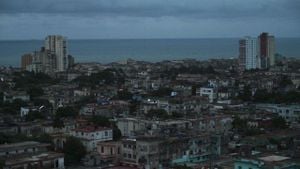New York City is facing serious challenges within its Rikers Island jail complex, leading to significant legal ramifications. A federal judge, Laura Taylor Swain, has ruled the city and its Department of Correction in contempt, citing failures to address violence and unsafe conditions within the facility, effectively raising the possibility of federal intervention.
The contempt ruling was made on November 27, 2024, and stemmed from years of documented complaints about conditions at Rikers. The Legal Aid Society, which filed the lawsuit leading to significant judicial oversight, highlighted the city’s inadequate response to previous rulings aimed at improving safety and reducing violence.
According to Judge Swain, conditions within Rikers are deteriorative. "Those who live and work in the jails on Rikers Island are faced with grave and immediate threats of danger," she noted, indicating systemic failures have created conditions where detainees are increasingly subjected to violence.
The judge's decision paves the way for potential receivership, which would place control of Rikers' management with federal authorities. This shift aims to address overwhelming rates of violence: incidents of physical force by staff rose dramatically from 4,652 times in 2016 to 8,184 incidents by 2021, as highlighted by Swain.
The city is tasked with developing a plan for potential federal oversight by January 14, 2025, and failure to comply with court orders could lead to even more severe penalties, including the jailing of city officials like Mayor Eric Adams.
Mayor Adams has rejected calls for federal oversight, asserting improvements under the current leadership of the Department of Correction. His administration describes the current commissioner, Lynelle Maginley-Liddie, as making steady progress, though this stance has been met with skepticism within judicial proceedings.
The impacts of recent bail reform legislation, which enabled fewer nonviolent offenders to remain detained pretrial, have been cited as contributing factors to the rising violence, as opponents of the reforms argue they have resulted in more serious offenders residing within Rikers. High proportions of the current inmate population face violent felony charges, reflective of the broader issues surrounding jail management.
Meanwhile, Judge Swain has overseen Rikers Island under continuous federal monitoring for nearly nine years since the initial lawsuit filed against the Department of Correction. Yet, she expressed frustration with the city's lack of substantive compliance or improvement, identifying 18 specific provisions from court orders the city has failed to address.
The rise of disturbing incidents, such as heightened rates of stabbings and inmate deaths—evident with 19 deaths recorded in 2022 alone—reflect the urgent calls for change. Many advocates, including lawyers from the Legal Aid Society, have emphasized the need for comprehensive reform at Rikers, pointing to systemic failures and inadequate oversight as key hurdles to addressing the urgent concerns at the facility.
Swain also referenced the excessive use of force by the officers, stating, "The current rates of use of force, stabbings and slashings, fights, assaults on staff, and in-custody deaths remain extraordinarily high." She indicated these rates have only worsened, pointing to what appears to be chronic mismanagement of the facility.
Critics of the city's approach argue forceful measures are necessary to take back control of Rikers. The president of the Correction Officers’ Benevolent Association, Benny Boscio, argued for necessary, not excessive, force to maintain safety within the facility, countering narratives about staff overreach and lack of resources.
The advanced scrutiny on Rikers is amplified by numerous lawsuits filed against the jail. More than 700 lawsuits include serious allegations of sexual abuse by correction officers against detainees, underscoring the multifaceted nature of the crises at Rikers Island. Legal advocates assert these incidents speak to larger systemic deficiencies needing immediate attention.
Swain's ruling serves as both a warning and a guiding light for reform groups who have long sought accountability and improved conditions at Rikers. "The ruling tells us... the efforts so far have not gotten us anywhere closer to compliance with the Constitution and with the law," stated Mary Lynne Werlwas from the Legal Aid Society, emphasizing the need for structural change.
Supporters of reform are hopeful the ruling may act as a tipping point, marking the beginning of much-needed changes at Rikers and possibly setting a precedent for how issues of this nature are handled moving forward. The prospect of federal oversight introduces the potential for reshaping the operational dynamics of not just Rikers, but also similar correctional facilities.
While criticisms of city leadership continue to intensify, city officials have defended their legacy improvements and pledged cooperation with federal oversight. The debate over governance structure at Rikers and the pursuit of meaningful reform seems far from resolved. Central to this discussion remains the health and safety of those—both staff and detainees—locked within Rikers Island, which continues to paint a concerning portrait of the challenges facing NYC's judicial and correctional systems.
The coming weeks will be pivotal as city leaders, legal advocates, and federal monitors work together—or potentially at odds—to create actionable and effective solutions to restore sanity to Rikers Island.



